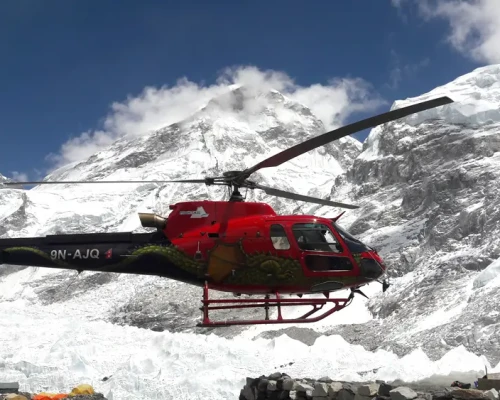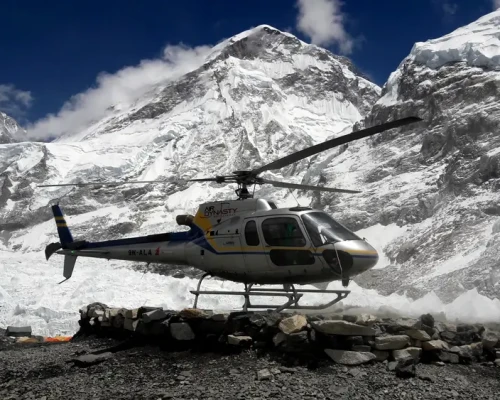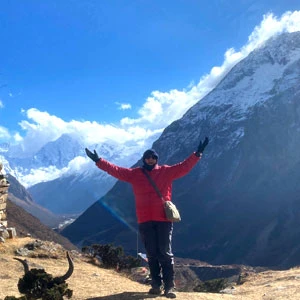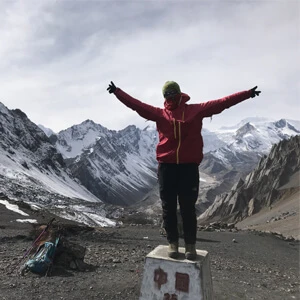Everest Base Camp Helicopter Tour
With its magnificent mountain scenery and lush, hidden valleys, Nepal is beautiful from every angle. Adventurers have been climbing, trekking, and discovering Nepal’s secrets for over forty years. Now it is possible to discover perhaps its last secrets from the air.
Helicopter flights offer a unique birds'-eye view of the world’s tallest mountains and deepest valleys as they take you deep into the spine of these ice-clad monsters. It is the ideal solution if you are short on time, or perhaps you just fancy the thrill. We use a modern fleet of helicopters that are proven and particularly well-suited for mountainous terrain and passenger comfort.
The Everest Base Camp Helicopter Tour is arguably the best flying experience in the world. The tour begins in Kathmandu, and then flies east to Lukla, the iconic Sherpa gateway to the Everest region. After a short stop for refueling, get ready for something very special: soaring up for a hawk-like view towards Mount Everest and many other great peaks. Gaze down on weathered gorges and the charming Sherpa villages, where Buddhist monasteries are perched precariously on narrow ridges. As you are effortlessly carried up into the harsh glacier moraine and above the Khumbu Glacier, cameras work overtime above the lushly forested foothills of the beautiful Dudh Kosi Valley. Spend a short time at Everest Base Camp or Kala Patthar (time is limited to around eight minutes due to the high altitude). There is still time to experience the surreal experience of a 360-degree dramatic panoramic view of Mt. Everest (8,848 meters) and the surrounding mountains, including Mt. Nuptse (7,861 meters), Mt. Lhotse (8,516 meters), Mt. Ama Dablam (6,812 meters), and Mt. Thamserku (6,623 meters). On the way back, stop for breakfast and a coffee (20 minutes) at Syangboche (Hotel Everest View). The name says it all, with more excellent views of Mt. Everest and its ranges. From here, you swoop back down to Lukla for refueling before the flight back to Kathmandu. Whether you are a solo traveler or looking to join a group, do not hesitate to contact the local experts.
In addition, you may like the Annapurna Base Camp Helicopter Tour, the Everest Base Camp Mountain Flight, and other attractive packages. Please contact us with your preferred dates, as we can often arrange them.
Is The Everest Helicopter Tour Safe?
Yes, the Everest Helicopter Tour is safe and an excellent option for travelers who wish to experience the grandeur of the Himalayas without the physical demands of the Everest Base Camp Trek. The tour involves a scenic flight to Everest Base Camp and Kala Patthar, operated by experienced pilots and reputable aviation companies. During this tour, you will follow strict guidelines including pre-flight inspections and weather assessments.
Now, while this journey does eliminate the physical demand of trekking, altitude sickness remains a potential threat. As you ascend rapidly to high altitudes, it can trigger Acute Mountain Sickness (AMS), such as headaches, nausea, dizziness, and shortness of breath. But do not worry, as you will only spend a brief time on the tour. Likewise, in case of emergencies, helicopter tours are well-equipped to handle medical situations. Pilots are well-trained and react quickly by descending to the lower level if any of the passengers faces any sort of difficulties. Additionally, most operators have partnerships with medical facilities in Kathmandu to ensure rapid access to treatment if necessary.
All in all, Nepal Trekking Experts ensure choosing a reputable helicopter operator who never compromises on safety measures, including experienced helicopter pilots, modern aircraft, climate conditions, and safety briefings. We make sure that you can enjoy the journey with peace of mind.
Best Time For Helicopter Ride to Everest
The Helicopter Ride to Everest is possible throughout the year. But considering the chance to see the striking appearance of the majestic peaks of Everest, Lhotse, Lobuche Peak, Island Peak, Nuptse, and other surroundings, you should opt to take this adventure in Spring (March to May) and Autumn (September to November).
These seasons are known for their excellent visibility and comfortable weather. Besides, these seasons cast their magical spell on the landscape to avail the beauty of nature.
At the same time, the temperature during the Winter (December to February) may be extreme. The snowy towering peak and the surrounding areas are converted into a world of snow that adds extra charm to the view. Since there will be stable weather, no obstruction in the panoramic views and less crowded, winter is also recommended.
Although the Summer season (June to August) is not recommended as it brings heavy clouds and rainfall, Helicopter flights can be often delayed and canceled. Due to low visibility, you will also have a hard time experiencing the grandeur of the Himalayas. Moreover, because of your safety reasons, NTE does not recommend taking Helicopter tours in the Summer season.
Note: Under the new regulations set by the Civil Aviation Authority of Nepal (CAAN), regular helicopter tours cannot land at Kala Patthar. Landing at Kala Patthar is permitted only with private charter flights for two people at a time. Please be aware of this change when planning your tour and confirm landing options with your tour operator.
Required Permits:
During the Helicopter Day Tour to Everest Base Camp, you will require two permits.
- Khumbu Pasang Lhamu Rural Municipality Entrance Permit: Costs NPR 2,000.
- Sagarmatha National Park Permit: Costs NPR 3,000.
Your helicopter tour operator will handle all the required permits and obtain them on your behalf, ensuring a smooth and hassle-free experience.
Booking With Nepal Trekking Experts
To book your Short Everest Helicopter Tour with Nepal Trekking Experts, please consider the following steps.
- Check the date availability of the flight. You can also directly call, message, or visit us for more details.
- Note that the landing places are only at Lukla and Everest View Hotel.
- Provide us necessary information before we confirm your booking such as your name, contact details, travel insurance, and a valid passport.
- To confirm your booking, you must send a initial deposit of 10% of the total cost of the tour. For your convenience, you may forward the deposit to us online through our website. It is completely safe, and as soon as you make it, you will get an automatic receipt in your inbox.
- After booking, check your email address for confirmation.
- Prepare for the tour as per the instructions and guidelines we provide after booking.









